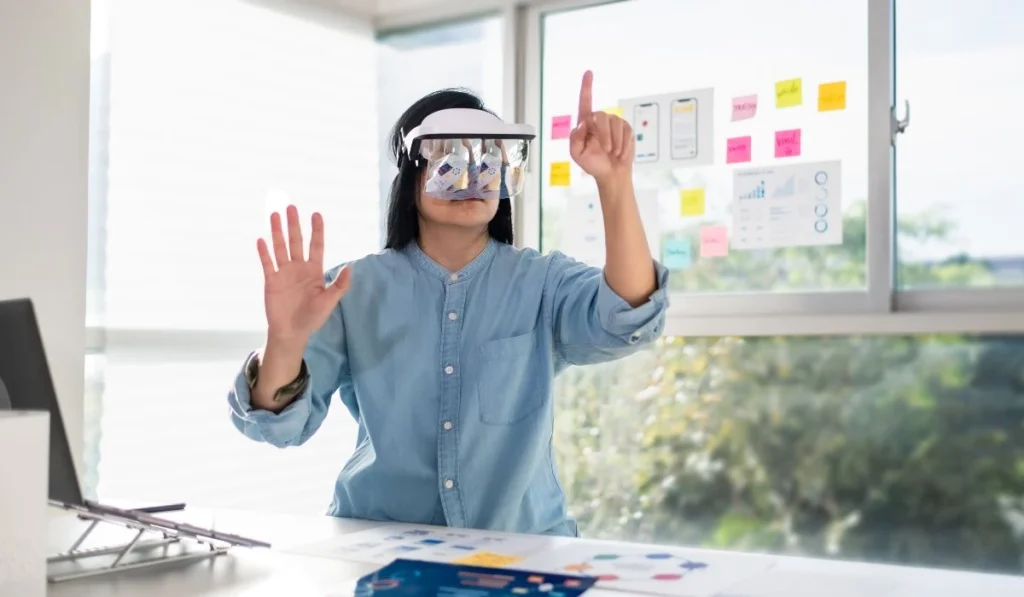Augmented Reality (AR) has rapidly transformed social media marketing, offering brands and marketers fresh ways to connect with their audience. As consumers increasingly demand immersive experiences, AR has become a powerful tool to capture attention, foster engagement, and boost conversions. Social media platforms like Instagram, Snapchat, Facebook, and TikTok have integrated AR capabilities, making it easier than ever for brands to leverage this technology. This blog will delve into the significance of AR in social media marketing, explore its benefits, and provide insights on how brands can use AR to their advantage.
What is Augmented Reality (AR)?
AR is a technology that overlays digital elements—such as sounds, videos, and graphics—onto the real world, enhancing users’ perception of their environment. Unlike virtual reality, which creates an entirely virtual space, AR blends digital elements into real-world settings. This blend between the digital and physical worlds offers unique, interactive experiences, and social media has emerged as a popular space for this innovation.
Why Augmented Reality Matters in Social Media Marketing
Social media marketing is highly visual and interactive, making AR a natural fit. AR on social media allows brands to create experiences that go beyond static images or videos, letting users “try on” products, explore virtual spaces, or see how products fit into their everyday lives without physically interacting with them. These interactive, engaging elements have led to higher engagement rates, deeper brand connections, and a surge in conversions, redefining how brands connect with their audiences.
Benefits of AR in Social Media Marketing
1. Enhanced Engagement and Interactivity
AR content can captivate users in a way traditional content cannot. For instance, Instagram and Snapchat filters let users personalize their interactions, whether by adding playful animations to selfies or visual effects to scenes. Brands that use AR filters or effects see higher engagement rates as people are more likely to share or interact with AR-driven posts.
2. Personalized Customer Experiences
AR offers personalized experiences, allowing customers to visualize products in their own space or even “try on” items like makeup, eyewear, or clothing. For example, beauty brands like Sephora and MAC have implemented AR try-on experiences that allow users to see how products look on their faces directly within the app. Such personalization increases customer confidence, making them more likely to complete a purchase.
3. Improved Conversion Rates
The ability to interact with products through AR boosts conversion rates by addressing customer hesitations. For example, furniture brands like IKEA use AR to let customers visualize how items will look in their homes. By bridging the gap between online browsing and in-store experience, AR eliminates uncertainty, ultimately driving higher sales.
4. Increased Brand Awareness and Recall
AR-powered campaigns have a unique impact on brand recall. Studies have shown that interactive AR experiences leave a lasting impression, as users are more likely to remember an engaging, hands-on experience compared to a passive one. Creative AR filters and lenses create memorable brand experiences that users are likely to share, further amplifying brand reach and recognition.
5. Encouragement of User-Generated Content (UGC)
AR filters often encourage users to create content. For example, a brand that launches a themed AR filter can prompt users to post their interactions, effectively turning them into brand advocates. This kind of user-generated content not only extends brand reach but also builds a sense of community and trust, as potential customers see real people engaging with the brand.
How Major Platforms are Integrating AR for Social Media Marketing
Several social media platforms have integrated AR technology to support brands and content creators in engaging audiences.
1. Instagram and Facebook
Meta has been at the forefront of integrating AR into social media with features like AR filters on Instagram and Facebook. Brands can create custom AR filters that allow users to interact with their products in unique ways. For instance, a clothing brand might create a filter that lets users “try on” outfits, or a food brand might use AR to overlay recipes on a user’s screen. Instagram’s Spark AR Studio has enabled creators and brands to develop tailored AR effects, making it easy to deploy on a massive scale.
2. Snapchat
Snapchat pioneered AR filters, commonly known as Lenses, and continues to be a leader in AR innovation. The platform’s Lens Studio allows brands to create custom AR experiences, from simple facial effects to complex interactive environments. Snapchat also introduced the concept of location-based AR, where users can interact with digital elements based on their physical location, adding another layer to brand storytelling.
3. TikTok
TikTok has recently incorporated AR into its platform with the introduction of AR Effects. Brands on TikTok can create interactive experiences that appeal to the platform’s younger, creative audience. With TikTok’s viral nature, AR experiences often gain traction quickly, allowing brands to reach a massive audience in a short time. AR effects are also highly customizable on TikTok, enabling brands to target niche audiences with unique, culturally relevant content.
4. Pinterest
Known for its visual discovery tools, Pinterest leverages AR to enhance product discovery, especially for home decor and beauty brands. Pinterest’s AR Try-On feature enables users to visualize makeup products on their own faces, helping bridge the gap between online exploration and purchase decisions. This feature is particularly useful for brands targeting a visually-inclined, creative audience.
Real-World Examples of AR in Social Media Marketing
1. Nike’s AR Shoe Try-On on Snapchat
Nike used Snapchat’s AR to create an interactive experience where users could virtually “try on” different shoe models. This feature not only increased user engagement but also saw an uptick in conversion rates as users could envision themselves wearing the products.
2. Sephora’s Virtual Artist on Instagram
Sephora integrated its Virtual Artist AR feature on Instagram, allowing customers to try on makeup products directly from the app. By reducing the need for physical sampling, Sephora made it easier for customers to experiment with different looks, leading to higher customer satisfaction and sales.
3. Pepsi’s Augmented Reality Billboard
Pepsi created an outdoor AR campaign that made bus stop billboards interactive, blending live scenes with AR animations. This campaign went viral and showcased how brands could use AR outside the digital space to create memorable and shareable experiences on social media.
Tips for Brands to Leverage AR in Social Media Marketing
- Create a Fun and Relevant Filter: AR filters should be aligned with your brand’s identity and relevant to your audience. Think about how the filter can add value to users’ social media experiences.
- Focus on User Experience: Ensure the AR experience is intuitive and enjoyable. Complex or glitchy filters might lead to frustration rather than engagement.
- Use Influencer Partnerships: Partner with influencers to promote your AR effects. Influencers can help introduce your AR experiences to a broader audience and encourage their followers to participate.
- Integrate AR with a Call-to-Action: Use AR experiences to guide users towards a specific action, such as visiting a website, making a purchase, or sharing the experience with friends.
- Experiment with Interactive Shopping Features: If you’re a product-based brand, consider adding AR features that allow users to “try before they buy.” This can be particularly effective for beauty, fashion, and home decor brands.
The Future of AR in Social Media Marketing
As AR technology evolves, the possibilities for brands to create even more immersive experiences will expand. AR glasses and wearable devices may one day become a part of everyday social media use, offering brands even more touchpoints to engage with customers in real-world settings. Additionally, as AI technology advances, AR content could become hyper-personalized, creating individualized experiences for every user.
For now, the integration of AR into social media marketing offers brands a powerful way to stand out, foster deeper connections, and drive tangible results. As consumers grow increasingly comfortable with AR, brands that embrace this technology will be well-positioned to capture attention, boost engagement, and lead the market in innovation.
Conclusion
AR is a game-changer in social media marketing, transforming passive browsing into interactive, engaging experiences. Brands that leverage AR, like Cafune Solutions, can create memorable moments, increase engagement, and drive conversions. As social media platforms continue to prioritize AR capabilities, companies that embrace this trend, such as Cafune Solution, will not only stand out in crowded feeds but will also pave the way for the future of digital marketing.







